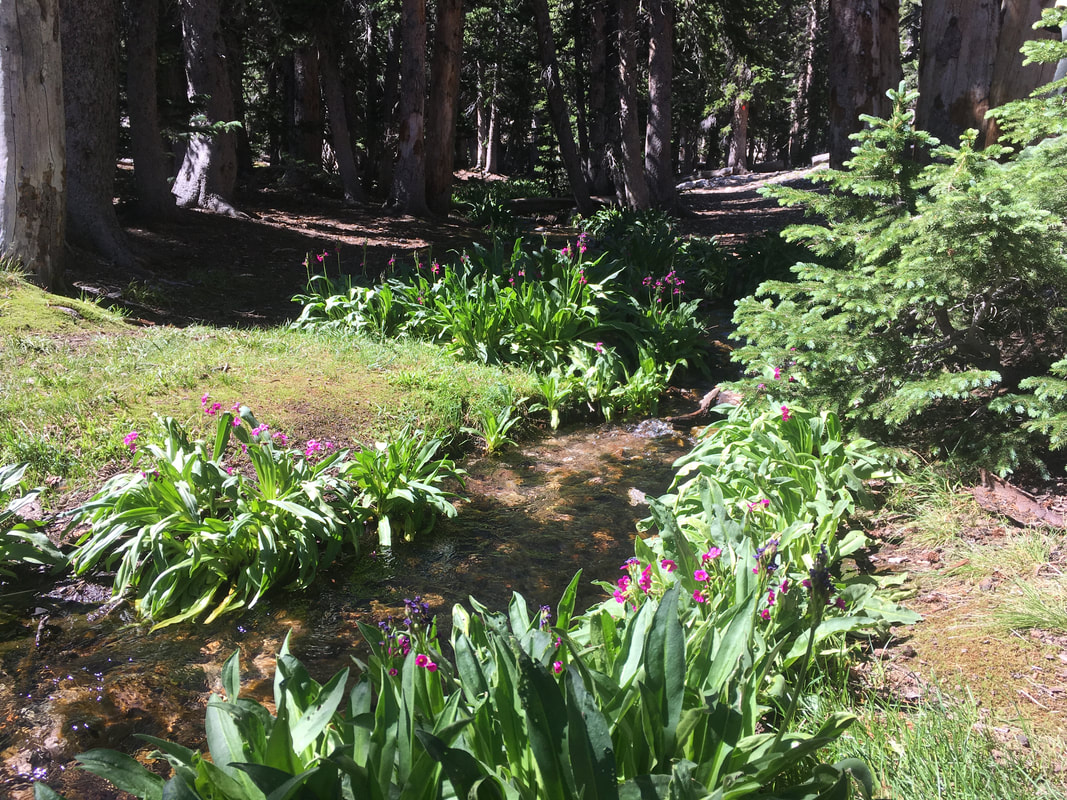Intoxicated with the beauty of life itself, eager to find and experience its wonders, he draws you into the wild, and then you see how once-clear brooks – so precious in the arid West - are trampled into mud by cattle and filled with their feces. With him you get up at dawn and watch wild bison being corralled by the Park Service, and hear
the moans of bulls and cows, the calling of the calves for their mothers, the cracking of the wrangler’s whips, the cruel voices of men…
Ketchum describes the suppression not just of wildlife but of responsible scientists and wildlife managers within the federal agencies, and the attempt to move responsibility for species protection to the states. But “In thirty-two state acts, there are no mechanisms whatsoever for recovery, consultation (with experts), and habitat designation. Moreover, states do not have the authority to regulate flora, a job assigned solely to federal agencies…plants make up 60% of listed endangered species” (p. 218). Flora and fauna coexist and species are disappearing at alarming rates because of the loss of habitat.
His description of the history of Wildlife Services, a branch of the Animal and Plant Health Inspection Service at the US Department of Agriculture, is exceptionally disturbing. Under the 1931 Animal Damage Control Act the government set out to protect livestock agriculture by killing potential predators with poisons, traps, and guns. Wolves, coyotes, foxes, bears, bobcats, cougars, wolverines, badgers, opossums, ravens, ferrets, porcupines, magpies, beavers, and prairie dogs, “keystone species in Western ecosystems”, were deemed “pests” (p. 181). Ketchum describes how people have been poisoned by cyanide traps meant for coyotes, placed on national lands for the benefit of sheepherders. He tried to get information from the Service, and learned that Congress itself has trouble doing obtaining this information. He found an ex-trapper willing to talk, who left the Service after attending a training at which dogs were horrifically killed to demonstrate the effectiveness of the cyanide spray. The trapper started yelling, telling the trainer to stop, but “He and the other trappers thought it was funny…(he) kicked the collie into the garbage pit ‘as it’s convulsing and dying and he’s laughing’” (p. 187).
When Ketchum describes the threat to grizzly bears from trophy hunting he notes that the Safari Club International, “a bastion of hyper-rich hobbyists, proclaimed that going after the grizzly was an expression of cultural legacy, part of the long hunting tradition in the West”. Ketchum suggests that the continent’s true hunting tradition was that of the Native American, which involved “complex relationships at the core of which were respect and honor. A moral universe encompassed the hunt… Theirs is better described as a killing tradition” (p. 274).
After covering environmental matters for many years for the New York Times Philip Shabecoff described how passionate hunter Aldo Leopold shot a mother wolf in 1909 from a distance, and how he reached her “in time to watch a fierce green fire dying in her eyes.” Leopold was “young then, and full of trigger-itch; I thought that because fewer wolves meant more deer, no wolves would mean a hunters’ paradise. But after seeing the green fire die, I sense that neither the wolf nor the mountain agreed with such a view” (p. 89).[2]
In Out of My Life and Thought philosopher, theologian and medical doctor Albert Schweitzer wrote that in 1915 he began a search for “something constructive” to solve the problem of civilization. “As I worked the connection between civilization and attitude toward life became clear to me. I recognized that the catastrophe of civilization stemmed from a catastrophe in this attitude” (p. 118). Responding to a realization that he was born into a time of spiritual decadence, he determined to affirm the principle of Reverence for Life, which gave him “firm footing and a clear path to follow” (p. 170). He wrote that
Affirmation of life is the spiritual act by which man ceases to live thoughtlessly and begins to devote himself to his life with reverence in order to give it true value. To affirm life is to deepen, to make more inward, and to exalt the will to live. At the same time the man who has become a thinking being feels a compulsion to give to every will to live the same reverence for life that he gives to his own. (p. 157)
In A Sand County Almanac, Leopold wrote that “An ethic, philosophically, is a differentiation of social from anti-social conduct”, and that this has to do with “the tendency of interdependent individuals or groups to evolve modes of co-operation. The ecologist calls these symbioses. Politics and economics are advanced symbioses in which the original free-for-all competition has been replaced, in part, by co-operative mechanisms with an ethical content” (p. 202). Yet when he wrote (1948), he observed that
There is as yet no ethic dealing with man’s relation to land and to the animals and plants which grow upon it…the land-relation is still strictly economic, entailing privileges but not obligations.
He offered his opinion that society should affirm what individuals have long noted, that “the despoliation of land is not only inexpedient but wrong” (p. 203).
Ketchum’s anger comes from a deep love of nature and respectful regard for what it has produced. His reporting reminds us the laws and agencies we created to manifest that respect are not working, that we are still primitively treating nature as property, as commodity, and without reverence.
At this time, as we are poised between the will to dominate and a rising up of a cultural demand for universal respect, we should expand our view from police actions and voting rights and specific laws. We can think broadly about reverence and respect, and how they can come, in a mature civilization, to replace the primitive mode of contest for dominance. Reinhold Neibuhr wrote in 1932 that individuals are able to “consider interests other than their own”, and are “endowed by nature with a measure of sympathy and consideration”, but this is more difficult for societies and social groups. “In every human group there is less reason to guide and to check impulse, less capacity for self-transcendence, less ability to comprehend the needs of others and therefore more unrestrained egoism”. He wrote:
The inferiority of the morality of groups to that of individuals is due in part to the difficulty of establishing a rational social force which is powerful enough to cope with the natural impulses by which society achieves its cohesion...[3]
Ketchum describes men like Robert Marshall, founder of the Wilderness Society, and Howard Zahniser, architect of the 1964 Wilderness Act. They represent that rational social force, which with enough support could become powerful enough to cope with the terrifying egoistic forces we see now vividly expressed in the destruction of environmental protections and the naked will to dominate. However, Ketchum describes, with coruscating emotional bitterness, the rise of what he calls collaborators, who try to work with industry and local interests to find ways to get their support for preservation. He hammers home the point that the balance tips steeply against the original idea of wilderness – and natural areas keep getting carved up, with motorized recreation, drilling, grazing and other destructive activities the prevailing outcomes. His take on the modern approach of the Big Green environmental organizations of accommodating anti-environmental interests, instead of simply fighting for nature itself, can only be called disgust. Ketchum’s criticism, often communicated in the words of his interviewees, is painful to read. Whether one thinks he goes too far or not, this book makes clear how urgent it is to understand better how we are failing to protect our heritage and how we must renew our attention to the visions of George Catlin, John Muir, David Brower, and all the others whose labors have stemmed the tide of despoliation.
It can be said that Ketchum’s anger can get in the way, that the picture he paints of corruption in Big Green organizations and government agencies veers into overgeneralization, and that his disappointment in the leadership of Democrats can lead to the false equation of parties. Even if extraction on federal lands increased during the Obama years, and the Wilderness Society has diluted its mission with compromise, it is still important to distinguish between those who can be redeemed and refocused, and those who whole-heartedly betray the future. But anyone who has felt the loyalty to natural beauty and wonder that Ketchum achingly portrays can forgive him his anger, and those who can’t must still absorb the terrifying facts he lays before readers:
Millions of acres logged, most of it old-growth; tens of millions of animals slaughtered by Wildlife Services; every year more than 155 million acres of BLM (Bureau of Land Management) land and 100 million acres of the national forests destructively grazed; hundreds of thousands of miles of new roads blazed, some 2.8 million roadless acres in our forests gone; tens of thousands of acres drilled for oil and gas or mined for precious metals and ores; the sage grouse headed for extinction, the last of the wild bison trapped in a tiny national park, the grizzly bear and the wolf clinging to the vestiges of the wild (p. 358).
Ketchum proposes we evict cows from the western lands where they never belonged. There would still be ample land to raise meat, and this would enable ecosystems to rebound. One study showed that after nine years without the cow, “total species richness increased 250 percent” (p 373). We could reduce high road-maintenance expenses as well as intrusions by eliminating roads. He rightly points out that we have many environmental laws that we only need to enforce. What we need to do is help the American public understand that this land is theirs, to own and protect, for the sake of our children and all present and future living things. If we want to take it back from those who are abusing it, we can.
There are many who hear the talk of protection of local economies and energy independence and do not look closer to see the losing compromise these fine-sounding policies allow. There are too few who insist that allowing species extinctions is disrespectful of the sanctity of creation; too few who look behind the shallow wildfire excuse for thinning forests. There are too many who think habitat protection is stifling economic growth, who do not understand or care that it only stops the wrong kind, and fosters the growth of sustainable local economies. These are times that test our vision as well as our souls. Those who identify themselves as citizens who own and are responsible for the preservation of our natural world can assert that identity. Is reverence for life a flowery idea in a book on a shelf? Or is it a spur to dedicated action?
[1] A 2013 article notes that transmission to cattle from bison herds has not happened for decades but continues from elk populations, and suggests the transmission from bison has ceased because of “rigorous management actions to keep cattle and bison spatially and temporally separated”. https://wwwnc.cdc.gov/eid/article/19/12/13-0167_article
[2] Shabecoff’s 1993 history of the American environmental movement was entitled A Fierce Green Fire.
[3]Moral Man and Immoral Society, Introduction.

 RSS Feed
RSS Feed

